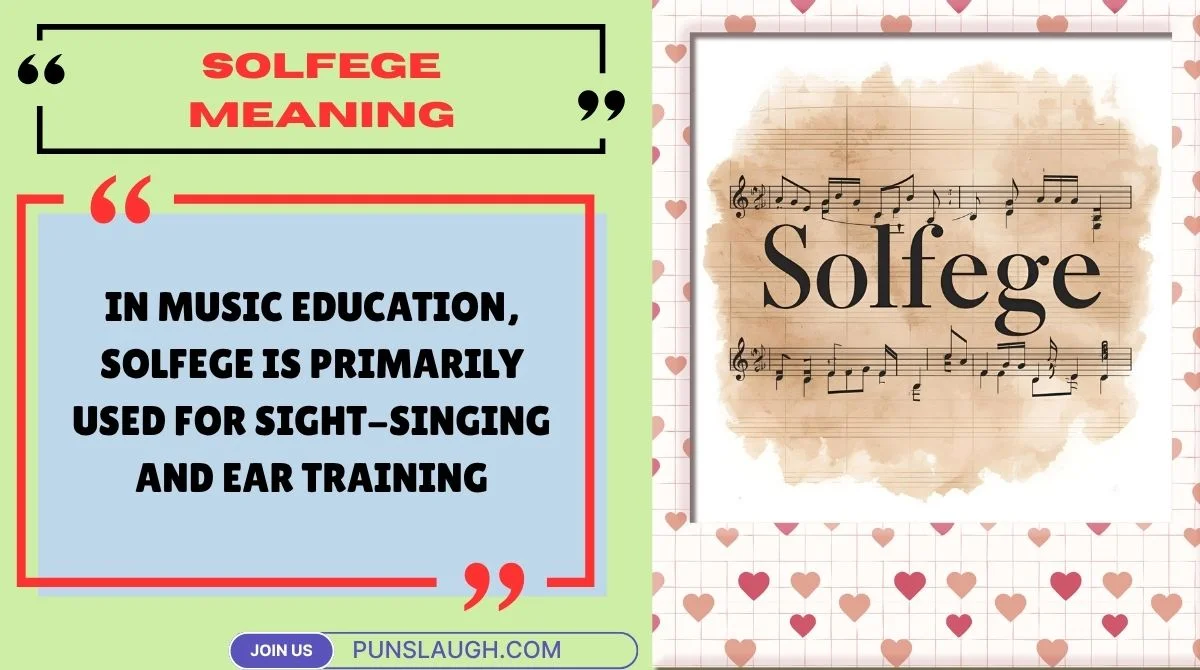Music is more than notes and rhythms; it’s a language, and solfege is one of its most powerful tools.
Whether you’re a singer, instrumentalist, or music enthusiast, understanding solfege meaning can transform how you perceive and perform music.
This guide dives deep into everything you need to know—from history and theory to practical exercises.
Understanding Solfege
The term solfege comes from the Italian word solfeggio, which itself originates from the first syllables of the musical scale: sol and fa.
At its core, solfege is a system of assigning syllables to musical notes. These syllables help musicians internalize pitch, read music more fluently, and improve their ear for melodies.
In simpler terms, solfege is like a musical alphabet. Just as letters form words, solfege syllables form melodies, making it easier to sing, play, or compose music accurately.
What Does Solfege Mean in Music?
In music education, solfege is primarily used for sight-singing and ear training. Each note of a scale corresponds to a syllable:
- Do, Re, Mi, Fa, Sol, La, Ti, Do
These syllables represent the scale degrees rather than fixed pitches (in the case of Movable Do) or absolute pitches (in Fixed Do).
Using solfege, musicians can:
- Recognize and reproduce pitches without an instrument
- Read sheet music more easily
- Improve improvisation and composition skills
For instance, a beginner might practice a C major scale by singing Do-Re-Mi-Fa-Sol-La-Ti-Do, internalizing the sound of each step in the scale.
Fixed Do vs Movable Do
Solfege systems differ depending on the teaching approach. Two primary methods exist:
| System | Definition | Example | Pros | Cons |
|---|---|---|---|---|
| Fixed Do | Each syllable corresponds to a specific pitch | Do = C, Re = D | Absolute pitch recognition; widely used in classical music | Less flexible for transposing music |
| Movable Do | Syllables represent scale degrees | Do = tonic of the current key | Improves relative pitch; better for sight-singing | Can be confusing for absolute pitch learning |
Fixed Do is popular in countries like France, Spain, and Italy, while Movable Do dominates in the US, UK, and many music education programs. Both methods have unique benefits, and professional musicians often learn both.
Solfege Spelling and Variants
You might notice different spellings: solfège (with accent) and solfege (without accent). The spelling with an accent is the traditional French form, while English texts often drop the accent.
Key points about spelling:
- Solfège: Academic, formal, and international notation
- Solfege: Common in informal English and online content
- Both are correct; context determines which to use
This distinction is small but important when citing sources or writing scholarly material.
Solfege Beyond Traditional Music
While solfege is mainly a music tool, it occasionally pops up in unexpected contexts:
- Internet and Slang: Memes and viral jokes may reference solfege syllables humorously.
- Astrology (Libra): Rarely, solfege terms are used metaphorically to represent balance and harmony in horoscopes.
- New York Times Crossword: Solfege occasionally appears as a clue, often relating to musical notes or syllables.
- Metaphorical Uses: Some texts in law or justice contexts use solfege to symbolize order or structure.
- Sports/Leisure: A few bowling guides whimsically use solfege to describe rhythm in throws.
While these uses are niche, they show that solfege’s influence extends beyond music classrooms.
Common Misconceptions About Solfege
Even music students can misunderstand solfege. Here are some myths:
- “It’s only for classical music.”
Modern jazz, pop, and even electronic musicians benefit from solfege exercises. - “You need perfect pitch to use it.”
Solfege trains your ear over time, making perfect pitch unnecessary. - “It’s outdated.”
Schools worldwide still teach solfege for sight-singing and ear training. - “It’s too complicated for beginners.”
Simple exercises, like singing a C major scale daily, can make solfege accessible to anyone.
Why Solfege Matters
Understanding solfege has practical and cognitive benefits:
- Improves musical memory: Helps retain melodies after hearing them once.
- Enhances sight-singing skills: Read and perform new pieces quickly.
- Supports improvisation: Internalize scale patterns for spontaneous creation.
- Assists in transcription: Identify notes by ear accurately.
In short, solfege is not just a teaching tool; it’s a skill that empowers musicians to interact with music confidently.
Benefits of Solfege Exercises
Daily solfege practice can produce measurable improvements:
- Pitch Accuracy
Singing scales and intervals trains your ear to recognize exact pitches. - Tonal Awareness
You’ll better understand key signatures and modal relationships. - Faster Music Learning
Musicians can sight-read complex pieces without constant instrument checking. - Improved Rhythm Recognition
Pairing syllables with rhythmic patterns strengthens overall musical timing.
Example Exercise Table:
| Exercise | Description | Skill Targeted |
|---|---|---|
| Major Scale | Sing Do-Re-Mi-Fa-Sol-La-Ti-Do | Pitch recognition |
| Interval Practice | Sing Do-Mi, Do-Sol, etc. | Ear training |
| Chromatic Solfege | Sing half-step increments | Advanced pitch accuracy |
| Melodic Dictation | Listen and write solfege | Music transcription |
Solfege for Beginners
Starting solfege doesn’t require advanced skills. Beginners can follow these steps:
- Step 1: Learn the syllables (Do-Re-Mi-Fa-Sol-La-Ti-Do).
- Step 2: Practice singing simple scales in C major.
- Step 3: Pair syllables with hand signs (Curwen hand signs) to reinforce learning.
- Step 4: Listen to melodies and try singing them using solfege.
- Step 5: Gradually add intervals, chromatic scales, and minor scales.
Tips for Success:
- Start slow and stay consistent.
- Use a piano or app to check accuracy.
- Combine solfege with sight-reading exercises.
Solfege in Real-Life Examples
Solfege isn’t just a theory—it’s actively used by professionals:
- Choir Directors: Teach pitch and harmony to large groups.
- Opera Singers: Memorize long arias using solfege syllables.
- Music Teachers: Introduce young students to scales and melodies.
- Jazz Musicians: Internalize chord progressions and improvisation patterns.
A practical example:
A choir practicing Do-Re-Mi from The Sound of Music learns pitch intervals faster when each note is associated with a syllable.
Advanced Solfege Applications
Once comfortable with basics, solfege can tackle advanced musical challenges:
- Complex Scales: Modes, chromatic scales, and bizarre scales.
- Jazz Improvisation: Internalizing chord tones and melodic patterns using solfege syllables.
- Composition: Writing melodies by singing solfege first, then notating them.
- Ear Training: Recognize and reproduce complex harmonies or atonal sequences.
Musicians often pair solfege with hand signs, rhythm clapping, and interval drills to maximize skill development.
Frequently Asked Questions (FAQs)
What is the difference between solfege and scales?
Solfege assigns syllables to scale degrees, whereas scales are sequences of pitches. Solfege helps internalize the scale’s sound.
Can solfege improve singing accuracy?
Yes, practicing solfege improves pitch recognition, making singers more precise and confident.
What is Movable Do versus Fixed Do?
Movable Do assigns Do to the tonic of any key, while Fixed Do assigns Do to a specific pitch like C. Both aid learning but serve different purposes.
How long does it take to learn solfege?
With daily practice, beginners can grasp basic solfege in 2–4 weeks, while advanced fluency may take months.
Are solfege exercises only for vocalists?
No, instrumentalists benefit equally by internalizing melodies, intervals, and chords.
Conclusion
Solfege is far more than a series of syllables; it’s a gateway to understanding and mastering music.
By learning solfege, musicians of all levels improve their ear, sight-reading, and overall musicality.
Whether you’re a beginner or advanced performer, integrating solfege exercises into your practice routine can unlock new levels of skill and creativity.
Start small, stay consistent, and let solfege guide your musical journey.





